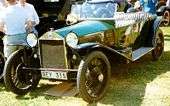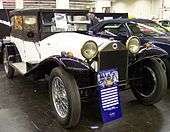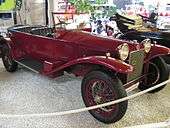Lancia Lambda
| Lancia Lambda | |
|---|---|
 Lancia Lambda Torpedo 1923 | |
| Overview | |
| Manufacturer | Lancia |
| Production | 1922–1931 |
| Body and chassis | |
| Body style |
Torpedo (S.1-S.9) Berlina (Weymann) (S.8-S.9) |
| Layout | FR layout |
| Powertrain | |
| Engine |
2119 cc Lancia V4 2370 cc Lancia V4 2568 cc Lancia V4 |
| Transmission |
3-speed manual (S.1-S.4) 4-speed manual (S.5-S.9) |
| Dimensions | |
| Wheelbase |
310 cm (122.0 in) (S.1-S.9) 342 cm (134.6 in) (S.6-S.9) |
| Curb weight | 1,200 kg (2,646 lb)-1,350 kg (2,976 lb) |
| Chronology | |
| Predecessor | Lancia Kappa (1919) |
| Successor | Lancia Artena |
The Lancia Lambda is an innovative automobile produced from 1922 through 1931. It was the first car to feature a load-bearing unitary body, (but without a stressed roof) and it also pioneered the use of an independent suspension (the front sliding pillar with coil springs).[1][2] Vincenzo Lancia even invented a shock absorber for the car and it had excellent four wheel brakes. Approximately 11,200 Lambdas were produced.
Nine versions of the Lambda were built:
- 1st series, produced 1923, 400 built.
- 2nd series, produced between 1923 and 1924, 1,100 built. Minor modifications for engine.
- 3rd series, produced 1924, 800 built. Engine modified.
- 4th series, produced between 1924 and 1925, 850 built. Modified windscreen.
- 5th series, produced 1925, 1,050 built. 4-speed gearbox.
- 6th series, produced between 1925 and 1926, 1,300 built. Car is sold now with bare chassis and with two wheelbases.
- 7th series, produced between 1926 and 1928, 3,100 built. New bigger engine.
- 8th series, produced between 1928 and 1930, 3,903 built. Again bigger engine.
- 9th series, produced 1931, 500 built. Last series sold only bare chassis.
Engines
The narrow-angle aluminium Lancia V4 engine was also notable. All three displacements shared the same long 120 mm (4.7 in) stroke, and all were SOHC designs with a single camshaft serving both banks of cylinders. First engine had 13° V angle, second 14° and 3rd 13° 40'.
| Model | Engine | Displacement | Power | Fuel system |
|---|---|---|---|---|
| S.1-S.6 | V4 SOHC | 2121 cc | 49 hp (36.5 kW) @ 3250 rpm | single carburetor |
| S.7 | V4 SOHC | 2375 cc | 59 hp (44 kW) @ 3250 rpm | single carburetor |
| S.8-S.9 | V4 SOHC | 2569 cc | 69 hp (51.5 kW) @ 3500 rpm | single carburetor |
Gallery
 Lancia Lambda (1923)
Lancia Lambda (1923) Lancia Lambda (1925)
Lancia Lambda (1925) Lancia Lambda (1925)
Lancia Lambda (1925) Lancia Lambda (1926)
Lancia Lambda (1926)- Lancia Lambda VII S (1927)
References
- Ray Bonds (2003). The Illustrated Directory of Sports Cars. Motorbooks. ISBN 0-7603-1420-9.
- Lancia by Michael Frostick, 1976. ISBN 0-901564-22-2
- ↑ "Autos Without Axles Promise Easier Riding" ''Popular Mechanics'', April 1932. Books.google.com. Retrieved 2015-08-23.
- ↑ Setright, L. J. K. (1976). "Overdrive". In Ian Ward. Anatomy of the Motor Car. Orbis. p. 159. ISBN 0-85613-230-6.
External links
| Wikimedia Commons has media related to Lancia Lambda. |
| Lancia car timeline, 1906–1930s — next » | |||||||||||||||||||||||||||||||||||
|---|---|---|---|---|---|---|---|---|---|---|---|---|---|---|---|---|---|---|---|---|---|---|---|---|---|---|---|---|---|---|---|---|---|---|---|
| Type | 1900s | 1910s | 1920s | 1930s | |||||||||||||||||||||||||||||||
| 6 | 7 | 8 | 9 | 0 | 1 | 2 | 3 | 4 | 5 | 6 | 7 | 8 | 9 | 0 | 1 | 2 | 3 | 4 | 5 | 6 | 7 | 8 | 9 | 0 | 1 | 2 | 3 | 4 | 5 | 6 | 7 | 8 | 9 | ||
| V4 | Augusta | Ardea | |||||||||||||||||||||||||||||||||
| Lambda | Artena | Aprilia | |||||||||||||||||||||||||||||||||
| I4 | 15 HP Zeta | ||||||||||||||||||||||||||||||||||
| 12 HP Alfa | 15/20 HP Beta | 20 HP Gamma | 20/30 HP Delta | 25/35 HP Theta | Kappa | ||||||||||||||||||||||||||||||
| 20/30 HP Epsilon | Dikappa | ||||||||||||||||||||||||||||||||||
| 30/50 HP Eta | |||||||||||||||||||||||||||||||||||
| I6 | 18 HP Dialfa | ||||||||||||||||||||||||||||||||||
| V8 | Astura | ||||||||||||||||||||||||||||||||||
| Trikappa | Dilambda | ||||||||||||||||||||||||||||||||||
This article is issued from Wikipedia - version of the 10/30/2016. The text is available under the Creative Commons Attribution/Share Alike but additional terms may apply for the media files.